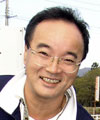
Featured Breeder
Hiroie Yamaguchi(Uonuma Nishikigoi) |
 |
Hiroie Yamaguchi is a breeder with superior techniques who has won the Japan grand champion for his Kohaku. His current focus is on Showa Sanshoku. He understands that Koi grow differently in different ponds; he checks and finds the best breeding method for each Koi and pursues the creation of an ideal Koi.
|
 I currently own 7 ponds, each one with different water quality and soil texture. It is generally said that sand is better to raise Showa Sanshoku, but I don’t think that’s necessarily true. I’ve made good Showa Sanshoku with argilliferous soil. A fry born from the same female Koi will have a different finish depending on the pond it is raised in. That is why I try and figure out everyday the best environment for each Koi. Compared to other types of Koi, Showa Sanshoku’s growth is greatly affected by the environment. The Uonuma district, where I reside, is fit for breeding Showa Sansoku, but even so I create 7 ponds with different quality, so I can find and provide the best environment for each of my Koi. I currently own 7 ponds, each one with different water quality and soil texture. It is generally said that sand is better to raise Showa Sanshoku, but I don’t think that’s necessarily true. I’ve made good Showa Sanshoku with argilliferous soil. A fry born from the same female Koi will have a different finish depending on the pond it is raised in. That is why I try and figure out everyday the best environment for each Koi. Compared to other types of Koi, Showa Sanshoku’s growth is greatly affected by the environment. The Uonuma district, where I reside, is fit for breeding Showa Sansoku, but even so I create 7 ponds with different quality, so I can find and provide the best environment for each of my Koi.
 I also am extremely sensitive to crossbreeding. I believe that one of the measures of making good Koi is genealogy, so I spare no effort in investing in oyagoi and lay stress on selecting them. But Koi production is not an easy job. Sometimes it seems like my efforts are not enough. Since Koi have recessive heredity, a fry of oyagoi with the most wonderful patterns and quality doesn’t always become a good Koi. Compatibility of two Koi is also important, but this is almost impossible to tell until they are actually bred. It is not an easy task judging that beforehand. Besides all that I’ve mentioned, a large amount of labor is needed to produce one good Koi. Even if I want to make a 3-year or 5-year old Koi, a reasonable lead time is needed of course, so it isn’t that easy. After doing a lot of thinking and giving it everything, only few truly good Koi live. This is a tough world, but then again, maybe that’s the interesting part of Nishikigoi, and that’ what is behind their scarcity value and popularity. I also am extremely sensitive to crossbreeding. I believe that one of the measures of making good Koi is genealogy, so I spare no effort in investing in oyagoi and lay stress on selecting them. But Koi production is not an easy job. Sometimes it seems like my efforts are not enough. Since Koi have recessive heredity, a fry of oyagoi with the most wonderful patterns and quality doesn’t always become a good Koi. Compatibility of two Koi is also important, but this is almost impossible to tell until they are actually bred. It is not an easy task judging that beforehand. Besides all that I’ve mentioned, a large amount of labor is needed to produce one good Koi. Even if I want to make a 3-year or 5-year old Koi, a reasonable lead time is needed of course, so it isn’t that easy. After doing a lot of thinking and giving it everything, only few truly good Koi live. This is a tough world, but then again, maybe that’s the interesting part of Nishikigoi, and that’ what is behind their scarcity value and popularity.
 Different from goldfish and tropical fish, Koi become big. As a small Koi grows to be 20cm (8inches), 50cm (20inches), and 80cm (32inches), its figure becomes more and more beautiful. Koi have beauty that grows with them, and I believe that is their greatest attraction. I’m sure it’s a pleasure for Koi lovers to watch their Koi grow big and beautiful. I emphasize the bone structure more than quality and patterns because I want the Koi lovers to enjoy and raise Koi for many years to come. I will keep on making efforts to creating my ideal Koi, Koi that Koi lovers will enjoy. Different from goldfish and tropical fish, Koi become big. As a small Koi grows to be 20cm (8inches), 50cm (20inches), and 80cm (32inches), its figure becomes more and more beautiful. Koi have beauty that grows with them, and I believe that is their greatest attraction. I’m sure it’s a pleasure for Koi lovers to watch their Koi grow big and beautiful. I emphasize the bone structure more than quality and patterns because I want the Koi lovers to enjoy and raise Koi for many years to come. I will keep on making efforts to creating my ideal Koi, Koi that Koi lovers will enjoy.
|
|



